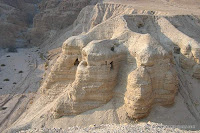The first scholar to recognize their antiquity was Prof. E.L. Sukenik, head of the Department of Archaeology at the Hebrew University. At the end of 1947, days before the outbreak of the War of Independence, he acquired three of the first seven scrolls. The other four were smuggled to the United States and in 1954 were acquired by Yigael Yadin, Sukenik's son, who was also an outstanding archaeologist.
Shortly after the discovery of the scrolls, a group of scholars under the leadership of Dominican priest R. de Vaux began to search and excavate the cave where the first scrolls were found, as well as some 40 caves in its vicinity. Many scrolls and thousands of fragments were found in 11 caves during the dig, which lasted from 1951 to 1956. A large complex of buildings was unearthed, which was used for communal activities - prayer, study, meals, and work. They used caves as sleeping quarters (remains were found in more than 30 caves), and evidently tents and huts as well.
The members of the Qumran sect belonged to a Jewish apocalyptic movement that left Jerusalem following an argument with the "Sons of Darkness" - their appellation for the Sadducees who served in the Temple. They chose a life of asceticism in the desert in order to separate themselves from the world of impurity and corruption, in preparation for the day when they would return and take over the Temple from the evil High Priest, emerging as victors in the war between the Sons of Light and the Sons of Darkness. One of the scrolls describes in detailed military terminology the details of that war.
The sect, which numbered 200 people at its peak, was self-supporting. Composed predominately of young celibate males (some women evidently also lived there), it was organized along communal principles, and based on maximum utilization of the region's resources (it has been described as an early kibbutz).
The sect had a fixed daily schedule: A typical day began before dawn with communal prayer. After this, each person did his own job, whether cultivating date palms, shepherding the animals, or performing services for the community, such as carrying water to the settlement, preparing food, or maintaining the buildings. In the afternoon, the community reconvened for prayers and ritual immersion. Towards dusk, after the community meal, were evening prayers. Each member undertook to dedicate a third of the evening hours to study.
Most of the Dead Scrolls are now found at the Shrine of the Book, a special site for exhibiting the scrolls built by the Israel Museum in Jerusalem. Strict atmospheric conditions are observed there to minimize the possible damage to the scrolls. The ruins of Qumran are under the auspices of the National Parks Authority. A souvenir shop, restaurant, and audiovisual presentation are on the premises.











